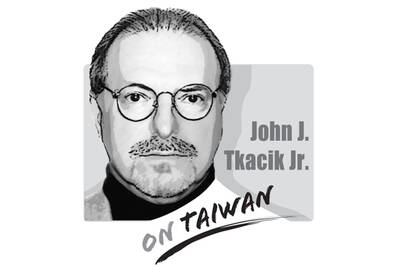One year ago, during the Tomb Sweeping Day holiday, a crane truck used to carry out remedial engineering works adjacent to a section of the Taiwan Railways Administration’s (TRA) east coast main line in Hualien County slid down a slope onto the tracks. A TRA Taroko Express train traveling eastward from New Taipei City to Taitung slammed into the crane truck. The crash killed 49 people and injured more than 200 people.
On the one-year anniversary of the incident, aside from displaying sympathy for families who have lost their loved ones, what reforms have bureaucrats introduced to ensure that such a disaster would never occur again?
Since the crash, a number of incidents have occurred involving engineering works near TRA railway tracks. Most of these have involved collisions between construction machinery and vehicles.
The Ministry of Transportation and Communications and the TRA said they have improved existing regulations governing the safety and management of engineering and construction work close to railway lines to more clearly define access controls into work areas. This falls far short of the systemic reforms that are required to reduce the risk from engineering work close to railway lines.
Any construction or civil engineering work that occurs close to railway tracks is, by definition, high risk. This risk can only be mitigated through careful project management and project monitoring.
The ministry had passed the “Measures for prohibiting and restricting construction on either side of railway lines.” At present, local governments, MRT corporations and Taiwan High Speed Rail (THSR) all carry out project risk assessments and evaluation of construction plans according to these measures. However, the TRA has not yet fully incorporated the measures into its own risk assessment procedures for work near railway tracks.
Despite last year’s devastating accident, the ministry still allows two separate trackside construction management systems to operate in parallel. The discrepancy between the robustness of the two systems is starkly reflected in the frequency of accidents and the number of casualties on the TRA network compared with those of the THSR and MRT networks.
Comprehensive safety impact assessment and monitoring of construction work adjacent to railway facilities is essential as it makes construction personnel aware of the impact their work has on the safety and operation of adjacent railway facilities, rather than simply focusing on safety within the confines of the construction site. By way of analogy, a surgeon must control a patient’s blood pressure and heart rate at the same time to ensure the safety of a surgical procedure.
The overall length of tracks under the jurisdiction of the TRA is longer than that of the THSR and local MRT networks combined, while the types of railway vehicles it operates are also more complex. The TRA also has to integrate four major systems within its network: transportation, engineering, systems and electrical power. Furthermore, given the TRA’s long history, it suffers from institutional inertia: Integrating new regulations and concepts is an uphill struggle and there is an ingrained resistance to change.
If the TRA cannot even modernize its management of trackside construction in line with basic standards already followed by the THSR and the MRT systems, it seems that the problem cannot be solved through corporatization alone: There is an attitudinal and cultural problem at the heart of the TRA.
Johnson Kung is a civil engineer.
Translated by Edward Jones
You wish every Taiwanese spoke English like I do. I was not born an anglophone, yet I am paid to write and speak in English. It is my working language and my primary idiom in private. I am more than bilingual: I think in English; it is my language now. Can you guess how many native English speakers I had as teachers in my entire life? Zero. I only lived in an English-speaking country, Australia, in my 30s, and it was because I was already fluent that I was able to live and pursue a career. English became my main language during adulthood

Somehow, US intelligence identified “the Houthis’ top missile guy” and pinpointed his exact location. At 1348 hours (Washington time), March 15, President Trump’s national security advisor Mike Waltz texted, “positive ID of him walking into his girlfriend’s building.” The unsuspecting Romeo entered. High above, the drone monitoring the building registered a flash. When the smoke cleared, Mr. Waltz texted, “…And it’s now collapsed.” RIP. The star-crossed “top missile guy” had been target number one in the now uproarious US Navy bombing campaign on that Sunday against the Yemeni rebels who have been holding the Red Sea hostage since October 19,
Taiwan on Monday celebrated Freedom of Speech Day. The commemoration is not an international day, and was first established in Tainan by President William Lai (賴清德) in 2012, when he was mayor of that city. The day was elevated to a national holiday in 2016 by then-president Tsai Ing-wen (蔡英文). Lai chose April 7, because it marks the anniversary of the death of democracy advocate Deng Nan-jung (鄭南榕), who started Freedom Era Weekly to promote freedom of expression. Thirty-six years ago, a warrant for Deng’s arrest had been issued after he refused to appear in court to answer charges of
The Opinion page has published several articles and editorials over the past few weeks addressing Taiwan’s efforts to leverage unique or strong aspects of its culture to increase international awareness of the nation. These have included submissions by foreign journalists and overseas students, highlighting how bubble milk tea, Guinness World Record attempts, the entertainment sectors, impressive scenery, world-class cuisine and important contributions to the high-tech supply chain can enhance Taiwan’s recognition overseas and therefore its soft power. That entails competing for attention in already crowded sectors. Other nations, after all, offer popular entertainment exports, beautiful scenic spots and great food.